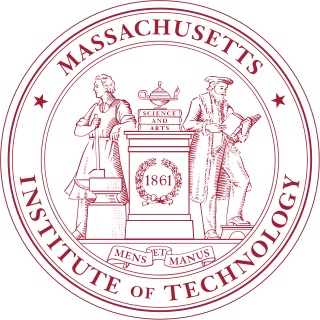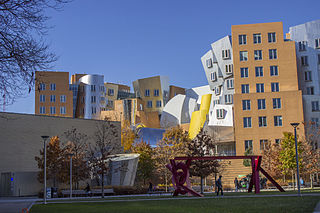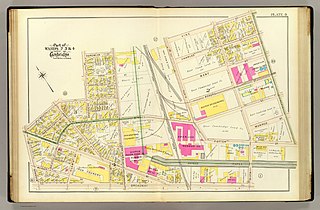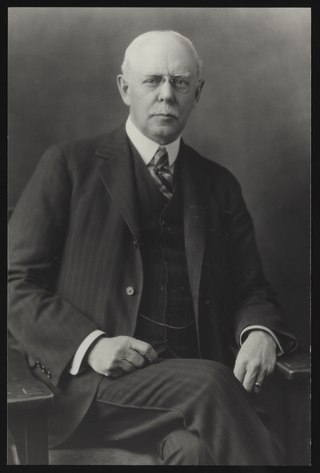
The Massachusetts Institute of Technology (MIT) is a private land-grant research university in Cambridge, Massachusetts. Established in 1861, MIT has played a significant role in the development of many areas of modern technology and science.

Stata Center, officially the Ray and Maria Stata Center and sometimes referred to as Building 32, is a 430,000-square-foot (40,000 m2) academic complex designed by Pritzker Prize-winning architect Frank Gehry for the Massachusetts Institute of Technology (MIT). The building opened for initial occupancy on March 16, 2004. It is located on the site of MIT's former Building 20, which had housed the historic MIT Radiation Laboratory, at 32 Vassar Street in Cambridge, Massachusetts.

The Sloan School of Management at Massachusetts Institute of Technology is the business school of the Massachusetts Institute of Technology, a private university in Cambridge, Massachusetts. MIT Sloan offers bachelor's, master's, and doctoral degree programs, as well as executive education. Its degree programs are among the most selective in the world. MIT Sloan emphasizes innovation in practice and research. Many influential ideas in management and finance originated at the school, including the Black–Scholes model, the Solow–Swan model, the random walk hypothesis, the binomial options pricing model, and the field of system dynamics. The faculty has included numerous Nobel laureates in economics and John Bates Clark Medal winners.

Kendall Square is a neighborhood in Cambridge, Massachusetts. The square itself at the intersection of Main Street and Broadway. It also refers to the broad business district east of Portland Street, northwest of the Charles River, north of MIT and south of Binney Street.

MIT Sloan Management Review is a magazine and multiplatform publisher. It features research-based articles on strategic leadership, digital innovation, and sustainable business. It aims to give readers practical, of-the-moment guidance for leading in an ever-shifting world. MIT SMR publishes in print quarterly and online daily. It creates content across various media, including web, app, podcast, live and recorded video, and via distributors and libraries worldwide.
Arthur D. Little is an international management consulting firm originally headquartered in Boston, Massachusetts, United States, founded in 1886 and formally incorporated in 1909 by Arthur Dehon Little, an MIT chemist who extended the applications of cellulose acetate, especially its use as artificial silk. Arthur D. Little pioneered the concept of contracted professional services. The company played key roles in the development of business strategy, operations research, the word processor, the first synthetic penicillin, LexisNexis, SABRE, and NASDAQ. Today the company is a multinational management consulting firm operating as a partnership.

Eric von Hippel is an American economist and a professor at the MIT Sloan School of Management, specializing in the nature and economics of distributed and open innovation. He is best known for his work in developing the concept of user innovation – that end-users, rather than manufacturers, are responsible for a large amount of innovation. In order to describe this phenomenon, in 1986 he introduced the term lead user.
Edward Baer Roberts is a faculty member at the MIT Sloan School of Management. He became the David Sarnoff Professor of Management of Technology in 1974.
The campus of the University of California, Berkeley, and its surrounding community are home to a number of notable buildings by early 20th-century campus architect John Galen Howard, his peer Bernard Maybeck, and their colleague Julia Morgan. Subsequent tenures as supervising architect held by George W. Kelham and Arthur Brown, Jr. saw the addition of several buildings in neoclassical and other revival styles, while the building boom after World War II introduced modernist buildings by architects such as Vernon DeMars, Joseph Esherick, John Carl Warnecke, Gardner Dailey, Anshen & Allen, and Skidmore, Owings and Merrill. Recent decades have seen additions including the postmodernist Haas School of Business by Charles Willard Moore, Soda Hall by Edward Larrabee Barnes, and the East Asian Library by Tod Williams Billie Tsien Architects.
Located in Cambridge, Massachusetts, the Global Innovation Management Institute (GIMI) was founded in 2002 as a research institute affiliated with the College of Business Administration at Northeastern University. The Institute focuses on applied, practice-oriented research and manages a number of research, education and outreach activities to communicate with academic audiences, students and corporations. It is partially funded by the US National Science Foundation (NSF) for its research on the global challenges facing technology intensive companies. Innovation frameworks, processes, and tools were developed through consulting engagements at Fortune 500 companies by consultants from Arthur D Little, the Monitor Group and IXL Center.

The GM Technical Center was inaugurated in 1956 as General Motors's primary design and engineering center, located in Warren, Michigan.

Alex Paul "Sandy" Pentland is an American computer scientist, the Toshiba Professor of Media Arts and Sciences at MIT, and serial entrepreneur.

Stuart E. Madnick is an American computer scientist, and professor of information technology at the MIT Sloan School of Management and the Massachusetts Institute of Technology school of engineering. He is the director of Cybersecurity at MIT Sloan (CAMS), formerly called the MIT Interdisciplinary Consortium for Improving Critical Infrastructure Cybersecurity ( ³).

General Electric Research Laboratory was the first industrial research facility in the United States. Established in 1900, the lab was home to the early technological breakthroughs of General Electric and created a research and development environment that set the standard for industrial innovation for years to come. It developed into GE Global Research that now covers an array of technological research, ranging from healthcare to transportation systems, at multiple locations throughout the world. Its campus in Schenectady, New York was designated a National Historic Landmark in 1975.

This is a list of sites listed on the National Register of Historic Places in Cambridge, Massachusetts. This is intended to be a complete list of the properties and districts on the National Register of Historic Places in Cambridge, Massachusetts, United States. Latitude and longitude coordinates are provided for many National Register properties and districts; these locations may be seen together in an online map.

Arthur Dehon Little was an American chemist and chemical engineer. He founded the consulting company Arthur D. Little and was instrumental in developing chemical engineering at the Massachusetts Institute of Technology (MIT). He is credited with introducing the term unit operations to chemical engineering and promoting the concept of industrial research.
This is a timeline of the history of the city of Cambridge, Massachusetts, United States.
Cambridge Discovery Park, formerly known as Acorn Park, is a 30 acres (12 ha) office and laboratory campus in Cambridge, Massachusetts. It is located along Massachusetts Route 2, and is connected to the Alewife Red Line subway terminus and bus station by a walking path, and to the Minuteman Bikeway.

Dame Fiona Elizabeth Murray is the Associate Dean for Innovation at the MIT Sloan School of Management. She is a member of the Prime Minister of the United Kingdom's Council for Science and Technology and Vice-Chair of the Board of Directors of the NATO Innovation Fund.

















